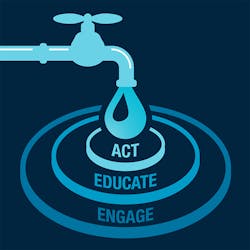Cummins to cut global water use in half by 2020
COLUMBUS, IN, MARCH 24, 2017 -- Cummins Inc. has increased its facility water goal to a 50% intensity reduction by 2020 from a baseline of 2010.
Cummins released its water conservation goal in 2014 as part of its 2020 Environmental Sustainability Plan, pledging to reduce water use intensity by 33 percent, adjusted by labor hours. As of the third quarter of 2016, the company's water efficiency efforts had resulted in a 42 percent intensity reduction or 18 percent on an absolute basis. Because the Company achieved the initial goal ahead of schedule, it revised its goal to be more aggressive.
The revised 50 percent intensity reduction goal represents a total water savings of 763 million gallons of water since 2010. That is equivalent to the water needed for drinking, sanitation and hygiene for 395,000 people for a year.
With facilities located around the globe from India to Indiana, the Company has installed low-flow fixtures and efficient equipment, bioswales and regenerative dynos, low water use landscaping, stopped water leaks, and otherwise worked toward efficient processes in its facilities.
"Thanks to the hard work of our employees around the world, we have surpassed our initial target, but we know we should do more and are raising the bar with a revised goal, " says Brian Mormino, Executive Director of Environmental Strategy & Compliance.
The United Nations (UN) estimates that by 2025, 1.8 billion people will be living in countries or regions with absolute water scarcity and two-thirds of the world population could be under water-stressed conditions. Projections show that by 2040 all of the United States will be considered highly water stressed.
"Businesses can't operate, and people can't live, without water," says Mormino. "We have a responsibility to come together in collective action, and Cummins is committed to being part of the solution."
The company's comprehensive water strategy addresses both direct water use and community engagement. Cummins has the opportunity through its more aggressive revised goal to amplify water efficiency efforts, which is important for several reasons: to mitigate business risk; to be a good global citizen and to reduce costs and compliance risk. In its water management program, the company uses innovative assessment tools such as the Ceres Aqua Gauge (one of the first companies to use this framework), a global water risk screen and the "true cost" of water assessment that identifies water costs embedded in activities such as pumping, electricity and chemical use.
To achieve the 50 percent reduction, Cummins will expand the work it does with its sites in water program management, including intensive engagement with higher water use locations, water balance creation and sub-metering. The company also has plans for high impact and showcase projects, such as an alternative bio-tech system for producing high quality treated wastewater for process reuse at one of its engine plants.
Cummins uses regenerative dynamometers (dynos) throughout the company to capture the mechanical energy of engines in test cells. The dynos also reduce cooling load, which allows cooling systems to be smaller and use less water.
Many Cummins buildings have specific features designed to conserve water. The bioswales at the new Distribution Business Unit headquarters in Indianapolis, for example, are part of a system designed to keep about 80 percent of rainwater on the site to use for landscaping. The bioswales collect and save water that would otherwise run into the city's sewer system. There are plants in India and Brazil that recycle water for non-potable uses and several locations have features like low or no-water toilet facilities to help meet their water-use goals.
Cummins also has a water neutrality goal that embodies the company's aspiration to work together with its communities to ensure that everyone has adequate, safe, and sustainable water supplies. By 2020, Cummins plans achieve water neutrality (offset the water it uses) at 15 facilities in water-stressed communities. This goal is aligned with the UN Sustainable Development Goal 6 for Clean Water and Sanitation.
About Cummins
Cummins Inc., a global power leader, is a corporation of complementary business units that design, manufacture, distribute and service diesel and natural gas engines and related technologies, including fuel systems, controls, air handling, filtration, emission solutions and electrical power generation systems. Headquartered in Columbus, Indiana, (USA) Cummins currently employs approximately 55,400 people worldwide and serves customers in approximately 190 countries and territories through a network of approximately 600 company-owned and independent distributor locations and approximately 7,400 dealer locations. Cummins earned $1.39 billion on sales of $17.5 billion in 2016.
